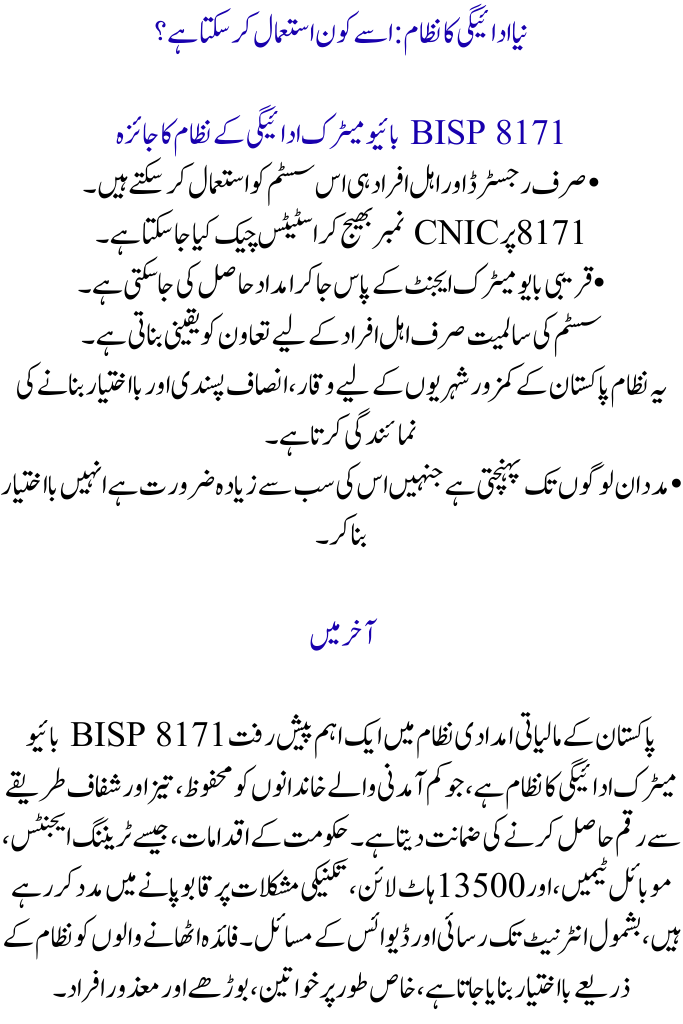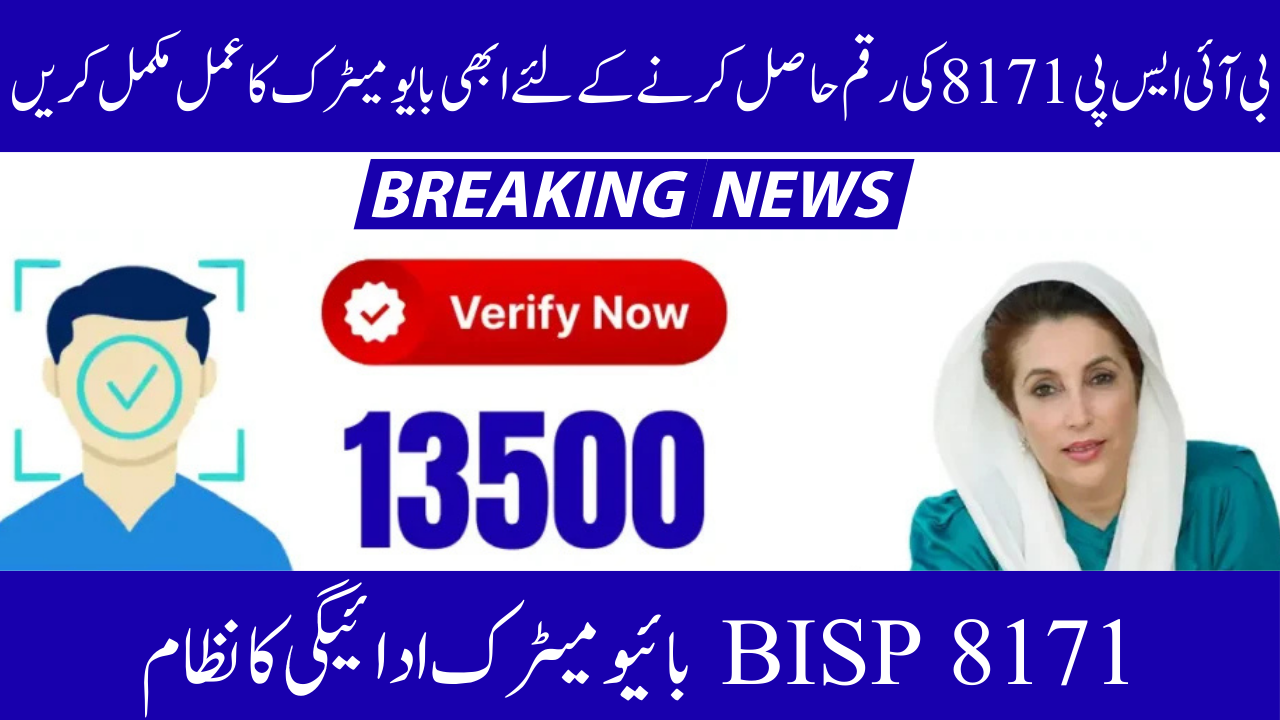BISP 8171 Biometric Payment System
In order to improve the delivery of financial help for low-income families under the Benazir Income Support Program, Pakistan implemented the BISP 8171 Biometric Payment System. This technique encourages accountability and transparency in assistance payments by substituting biometric verification for manual processes. Since millions of people depend on this assistance, the implementation of biometric technology represents a move toward efficiency by doing away with lengthy lines and the need for middlemen, enabling rapid and safe access to financial help.
You can read more:Reopening of the BISP 8171 Web Portal in September 2025 Eligibility for the Rs. 13,500 Stipend Verified
The Need for the Biometric Change
A biometric payment system has been implemented by the Benazir Income Support Programme (BISP 8171) to solve the problems of fraud, mistakes, and delays in cash collection. Biometric fingerprint scans are used to identify beneficiaries, guaranteeing that the funds are disbursed to the correct individual. Particularly in rural places where access to digital infrastructure and banking has historically been restricted, this shift has been warmly embraced. The system has received recognition for its efficacy and efficiency in lowering fraud and money collection delays. It is anticipated that the system would significantly advance the quality of financial services offered to recipients.
Overview of the Program
Benazir Income Support Programme (BISP) Features
• Payment method: Biometric fingerprint verification.
• Accessibility: Designated agents in urban and rural areas.
• Support Helpline: 13500.
• Benefits: Fast, secure, fraud-free payment process.
• Common Issues: Technical errors in remote regions. Solutions: Mobile teams and agent training.
The Operation of the BISP 8171 Biometric Payment System
With the new method, registered recipients can get financial aid using biometric devices instead of ID cards or other paperwork. In order to ensure the comfort of elderly or handicapped people and facilitate their access to assistance, agents are trained to use biometric equipment and help those who are not familiar with the procedure.
You can read more: BISP 8171 Payment Deduction End and New Withdrawal Process Announced Full Guide
| Category | Details |
|---|---|
| Payment Method | Biometric fingerprint verification |
| Who Can Use It | Registered and eligible BISP beneficiaries |
| How to Check Status | Send CNIC number to 8171 |
| Where to Collect Aid | Nearest biometric payment agent (urban & rural areas) |
| Support Helpline | 13500 for complaints, guidance, and payment updates |
| Main Benefits | Fast payments, reduced fraud, transparency, and improved accessibility |
| Problems | Technical faults in rural places, lack of knowledge, and problems with the internet and power |
| Solutions Provided | Mobile teams, agent training, and ongoing system improvements |
Advantages for the Recipients
BISP 8171 Biometric Payment System:
• Reduces fraud through fingerprint authentication.
• Facilitates faster transactions, reducing waiting times.
• Increases accessibility across remote areas via local agents.
There are still difficulties.
Not many beneficiaries are acquainted with fingerprint verification, and technical problems resulting from inadequate internet connectivity or power outages are among the difficulties the BISP is resolving in the biometric device verification system. The system is providing assistance through skilled field workers and sending mobile teams to handle these problems. Making sure no qualified individual is left behind because of ignorance or lack of access is the aim. The system is intended to ensure the safety and security of people with disabilities by facilitating their access to and use of biometric equipment.
13500 Helpline for Support
The 13500 helpline was established by the government to aid beneficiaries with payment-related concerns, offering prompt advice, addressing grievances, and informing individuals of their eligibility and payment status. When used in conjunction with the BISP 8171 Biometric Payment System, this hotline improves public-administrator communication.
Pakistan’s Prospects for Biometric Welfare Payments
By connecting government assistance programs to biometric technology, the BISP is enhancing its welfare model through the implementation of a new system that will allow citizens to access aid with a single digital ID. The system also aims to improve infrastructure, especially in remote areas, with the potential for mobile biometric units in the future.
You can read more: Flood-affected individuals’ BISP eligibility has been expanded, and the 8171 portal has reopened to reflect the updated payment status.
The New Payment System: Who Can Use It?
BISP 8171 Biometric Payment System Overview
• Only registered and eligible individuals can use this system.
• Status checks can be done by sending the CNIC number to 8171.
• Aid can be received by visiting the nearest biometric agent.
• System integrity ensures support only for qualified individuals.
• The system represents dignity, fairness, and empowerment for Pakistan’s vulnerable citizens.
• Help reaches those most needing it by empowering them.
In conclusion
An important development in Pakistan’s financial aid system is the BISP 8171 Biometric Payment System, which guarantees low-income families get money in a safer, quicker, and more transparent manner. The government’s initiatives, such as training agents, mobile teams, and the 13500 hotline, are assisting in overcoming technological difficulties, including internet access and device problems. Beneficiaries are empowered by the system, especially women, the elderly, and those with impairments.

FAQs
1. How can I determine if I qualify for biometric payments under BISP 8171?
By phoning the 13500 helpdesk or texting your CNIC number to 8171, you may verify your eligibility.
2. How do I proceed if my fingerprint is not accepted?
See another biometric agent or contact the 13500 hotline for assistance if your fingerprint is not recognized. In certain situations, mobile teams might also be of assistance.
3. Is it simple for recipients in remote locations to get biometric payments?
Indeed. In both urban and rural regions, the government has deployed biometric agents. To guarantee that all eligible families may get their help, mobile teams are sent to outlying areas.
